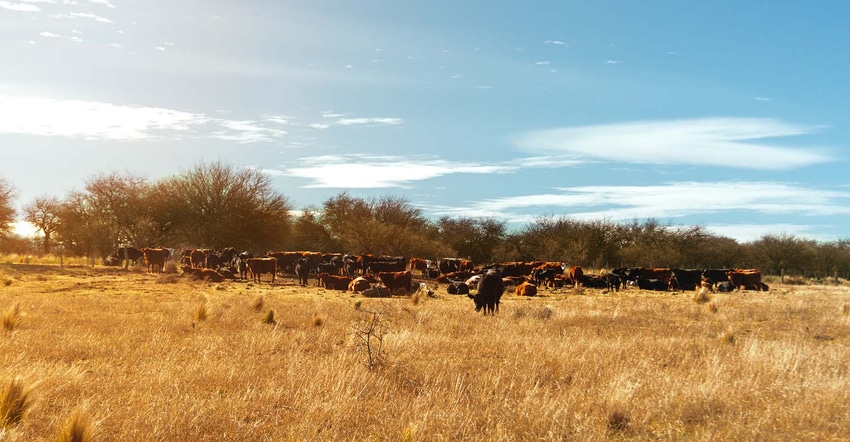
by Jen Skerritt
The pastures on Craig Todd’s ranch in western Canada are so scorched by all the hot, dry weather in recent months that his cattle have little to eat. After spending C$10,000 ($8,110) on extra feed pellets -- an unplanned expense for a herd that should be munching on free grass -- Todd is now considering selling as many as 50 animals to get through winter.
“I might knock a few more off” to reduce costs, said Todd, whose raises cattle on land an hour’s drive west of Swift Current, Saskatchewan. “Going into next year, if we don’t get any rain, I’m in as much trouble as most people are.”
For Canada, the world’s sixth-largest beef exporter, a worsening drought across the southern Prairie provinces has probably ended any chance of a rebound for the domestic cattle industry. The herd was hit by several cases of mad-cow disease more than a decade ago, followed by floods and labor shortages. In 2015, it shrank to a 22-year low.
The herd was expected to expand slightly this year, but deteriorating grazing conditions have driven up the price of hay used as feed to as much as C$200 a ton, twice as much as a year earlier. Some ranchers will cull more animals from their herds to reduce costs after parts of Saskatchewan and Alberta got less than 60% of normal rainfall since April 1, according to Agriculture and Agri-Food Canada, a government agency.
In Saskatchewan, pastures and hay land have suffered greatly from the lack of moisture and will need significant rainfall, the province’s agriculture ministry said Thursday in a report. Thirty-five percent of the province’s pastures are in poor condition and 30 percent are rated "very poor," it said.
“This drought pretty much takes herd growth off the table,” said Brian Perillat, a senior analyst at Calgary-based Canfax. “There will be a few guys short of feed who will have to cull a little harder.”
Ranchers held 12.95 million cattle as of July 1, up less than 1% from a year earlier, according the the most-recent data available from Statistics Canada. Since then, with pastures drying up and the cost of feed rising, some producers probably will unload more animals by selling young cattle or sending breeding cows to be slaughtered.
Falling Prices
With concern that more cattle will be sold, prices already are dropping. Cows sold for slaughter fetch about 86 Canadian cents a pound, down from 91 cents a year earlier, according to data compiled by Canfax, the market analysis division of the Canadian Cattlemen’s Association. Steer calves weighing 550 pounds (250 kilograms) are down 15 percent since the spring, to about C$2.15 a pound, while heifers dropped even more, to C$1.87 a pound from C$2.22 earlier this year.
“There will be some people who will be weaning calves earlier and selling calves earlier than they normally would,” said Rich Smith, executive director of Calgary-based Alberta Beef Producers. “Their grass is in poor condition, as you’d expect from lack of rainfall, and they’re deeply worried about fire.”
Across the border in the northern U.S., conditions aren’t much better.
During the summer, ranchers sold off cattle as drought withered pastureland and hay crops. Some spring-wheat fields were baled for use as animal feed, because yields were too poor to harvest the grain for human consumption. The U.S. Department of Agriculture opened some conservation lands for emergency grazing in Montana, North Dakota and South Dakota. The states were home to 8.3 million cattle as of Jan. 1, or 9% of the nation’s herd, USDA data show.
Rain fell during August and September in North Dakota, and after that, “the mass liquidation slowed up considerably,” said Tim Petry, a livestock economist at North Dakota State University in Fargo. “We’re still in a drought, but conditions are better.”
Dry Spell
Central and eastern Montana continue to suffer from dryness, with more than two-thirds of the state facing severe to exceptional conditions, U.S. Drought Monitor data show.
There’s little drought-relief in sight for Saskatchewan and southern Manitoba, Brett Anderson, a senior meteorologist at AccuWeather, said in a Sept. 7 report. Precipitation across the region will be below normal, with a higher-than-average risk of fires, he said.
In Alberta, Canada’s largest beef producer, 37% of pastures are in poor condition, the province’s agriculture ministry said in a Sept. 15 report. Warm, dry weather has depleted soil moisture, especially in the southern and central regions, according to the report.
In parts of Saskatchewan, hay prices are running between C$160 and C$200 a ton, up from about C$80 a year earlier, said Don Connick, who farms and runs a small cattle herd in Gull Lake. The area got just 2 inches of rain all season, about a quarter of what’s normal, and some pastures have been extremely overgrazed, he said.
Pastures in the area “are pretty dismal,” Connick said. “We’ve had an extremely hot, dry summer here. The grass is all dry and brown.”
--With assistance from Megan Durisin. To contact the reporter on this story: Jen Skerritt in Winnipeg at [email protected]
To contact the editors responsible for this story: Simon Casey at [email protected]
Steve Stroth
© 2017 Bloomberg L.P
About the Author(s)
You May Also Like




